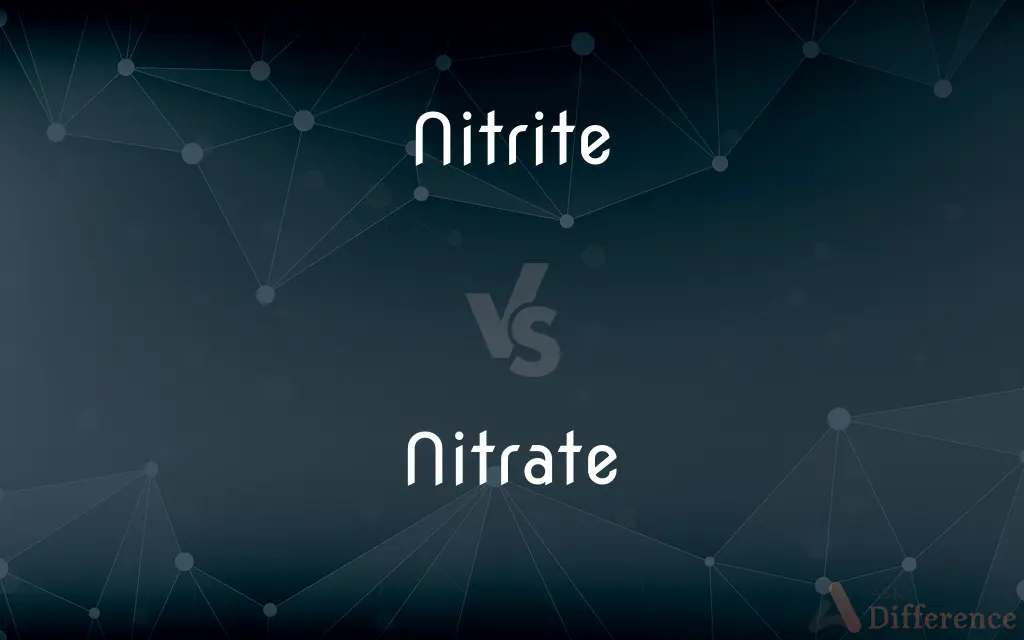Nitrite vs. Nitrate — What's the Difference?
Edited by Tayyaba Rehman — By Fiza Rafique — Updated on November 2, 2023
Nitrite (NO2-) has one nitrogen atom bonded to two oxygen atoms, while Nitrate (NO3-) has one nitrogen atom bonded to three oxygen atoms.

Difference Between Nitrite and Nitrate
Table of Contents
ADVERTISEMENT
Key Differences
Nitrite, with the chemical formula NO2-, consists of one nitrogen atom paired with two oxygen atoms. It is a polyatomic ion with a charge of -1. Nitrate, however, is composed of one nitrogen atom and three oxygen atoms, symbolized as NO3-, and also carries a -1 charge. Both play significant roles in the nitrogen cycle but at different stages.
Nitrites are often found in nature as a product of the nitrogen cycle, especially during the process of nitrification and denitrification. They are also used in food preservation, especially in curing meats. Nitrates, in contrast, are commonly used in fertilizers and occur naturally in soil and water as part of the nitrogen cycle, providing essential nutrients for plant growth.
The human body interacts with nitrites and nitrates differently. Nitrites can form nitrosamines, some of which are carcinogenic, particularly when meat containing nitrites is cooked at high temperatures. Nitrates, while less reactive, can be converted into nitrites in the body, which requires monitoring in dietary intake to prevent potential health risks.
In terms of environmental impact, excess nitrites in water can lead to eutrophication and affect aquatic life. Nitrates, while less toxic, can also contribute to eutrophication if not managed properly. Both chemicals need to be carefully managed to prevent environmental damage.
In the industrial context, nitrates are used in the production of explosives, where they act as an oxidizing agent. Nitrites are less commonly used in industrial applications but can be found in some industrial processes and products, such as dyes and pharmaceuticals.
ADVERTISEMENT
Comparison Chart
Chemical Structure
One nitrogen, two oxygens
One nitrogen, three oxygens
Oxidation State
Nitrogen at +3 oxidation state
Nitrogen at +5 oxidation state
Environmental Role
Intermediate in nitrogen cycle
End product in nitrogen cycle
Toxicity
Potentially toxic, forms nitrosamines
Generally less toxic than nitrites
Industrial Use
Used in meat curing, dyes
Used in fertilizers, explosives
Compare with Definitions
Nitrite
Nitrite is often used as a coloring agent and preservative in food.
Consuming too much nitrite can lead to health complications.
Nitrate
Nitrate is an anion with the formula NO3- commonly found in fertilizers.
Calcium nitrate is widely used to provide nitrogen to plants.
Nitrite
Nitrite is an anion with the formula NO2- used in food preservation.
Sodium nitrite prevents the growth of bacteria in cured meats.
Nitrate
Nitrate compounds are often used in making explosives and propellants.
The storage of nitrates must be managed carefully due to their explosive potential.
Nitrite
Nitrite is a compound that can contribute to the nitrogen cycle in nature.
Nitrites must be monitored in aquariums to ensure fish health.
Nitrate
Nitrate can be reduced to nitrite in the body, affecting health.
Vegetables are a major dietary source of nitrates.
Nitrite
Nitrite refers to a salt or ester of nitrous acid.
Nitrite levels in the water supply are strictly regulated.
Nitrate
Nitrate refers to a salt or ester of nitric acid.
Potassium nitrate is an ingredient in some toothpastes for sensitive teeth.
Nitrite
The nitrite ion has the chemical formula NO−2. Nitrite (mostly sodium nitrite) is widely used throughout chemical and pharmaceutical industries.
Nitrate
Nitrate is a naturally occurring compound in the nitrogen cycle.
Groundwater can become contaminated with nitrates from agricultural runoff.
Nitrite
A salt or ester of nitrous acid, containing the anion NO₂⁻ or the group —NO₂.
Nitrate
Nitrate is a polyatomic ion with the chemical formula NO−3. Salts containing this ion are called nitrates.
Nitrite
The univalent anionic group NO2, derived from nitrous acid, or a compound containing this group.
Nitrate
A salt or ester of nitric acid, containing the anion NO₃⁻ or the group —NO₃
Preserved meat and vegetables contain nitrates
Fish-fry populations are damaged by nitrate
Nitrite
(chemistry) Any salt or ester of nitrous acid.
Nitrate
Treat (a substance) with nitric acid, especially so as to introduce nitro groups
A powerful nitrating agent
Nitrated polycyclic aromatic hydrocarbons
Nitrite
(chemistry) The univalent radical -NO2, and the anion NO2-
Nitrate
The univalent anionic group NO3, derived from nitric acid, or a compound containing this group.
Nitrite
A salt or ester of nitrous acid; a compound bearing the -NO2 radical.
Nitrate
Fertilizer consisting of sodium nitrate, potassium nitrate, or ammonium nitrate.
Nitrite
The radical -NO2 or any compound containing it (such as a salt or ester of nitrous acid)
Nitrate
To treat with nitric acid or a nitrate, usually to change (an organic compound) into a nitrate.
Nitrite
Nitrite acts as an intermediate in the biological nitrification process.
The conversion of ammonium to nitrite is a crucial step in wastewater treatment.
Nitrate
(chemistry) Any salt or ester of nitric acid. Category:en:Nitrogen
Nitrate
To treat, or react, with nitric acid or a nitrate
Nitrate
A salt of nitric acid.
Nitrate
Any compound containing the nitrate group (such as a salt or ester of nitric acid)
Nitrate
Treat with nitric acid, so as to change an organic compound into a nitrate;
Nitroglycerin is obtained by nitrating glycerol
Common Curiosities
Where are nitrites found naturally?
Nitrites are found in the environment, particularly in water and soil as part of the nitrogen cycle.
Why are nitrates important in agriculture?
Nitrates are key nutrients that enhance plant growth and crop yields in agriculture.
Are nitrites carcinogenic?
Nitrites can form carcinogenic nitrosamines, especially when combined with amines in the presence of heat.
Can nitrate be harmful to humans?
High levels of nitrate can be harmful, especially if converted to nitrite in the body.
How do nitrates affect the environment?
Nitrates can contribute to water pollution and eutrophication if they leach into water bodies.
What is nitrite used for?
Nitrite is used in curing meats, as a color fixative, and as a preservative.
Are nitrite levels regulated in drinking water?
Yes, there are regulatory limits for nitrite levels in drinking water to ensure safety.
What is the major health concern with nitrate ingestion?
The primary concern is the conversion of nitrates to nitrites, which can lead to health issues like methemoglobinemia.
Can the body naturally produce nitrates?
Yes, the body produces nitrates as part of the normal metabolic processes.
What foods commonly contain nitrites?
Processed meats like bacon, sausages, and ham often contain nitrites.
How are nitrites converted to nitrates?
Nitrites can be oxidized to nitrates through microbial action in the soil or water.
Share Your Discovery

Previous Comparison
Analogy vs. Metaphor
Next Comparison
Affinity vs. AvidityAuthor Spotlight
Written by
Fiza RafiqueFiza Rafique is a skilled content writer at AskDifference.com, where she meticulously refines and enhances written pieces. Drawing from her vast editorial expertise, Fiza ensures clarity, accuracy, and precision in every article. Passionate about language, she continually seeks to elevate the quality of content for readers worldwide.
Edited by
Tayyaba RehmanTayyaba Rehman is a distinguished writer, currently serving as a primary contributor to askdifference.com. As a researcher in semantics and etymology, Tayyaba's passion for the complexity of languages and their distinctions has found a perfect home on the platform. Tayyaba delves into the intricacies of language, distinguishing between commonly confused words and phrases, thereby providing clarity for readers worldwide.















































